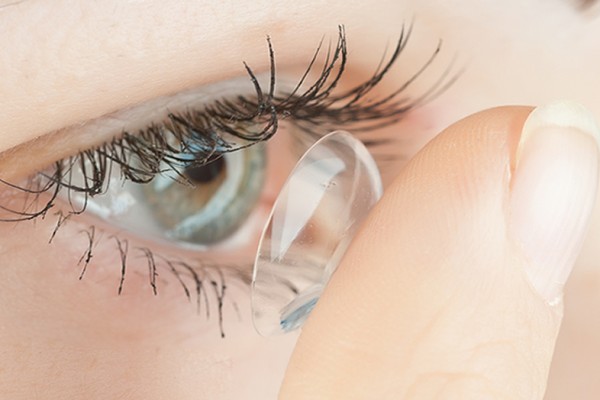This post is also available in:
![]() Français (French)
Français (French)
The more you look at a digital screen, the more uncomfortable your eyes can get. Not much of a surprise right? Nonetheless, it’s something you should try to stay mindful of.
Computer vision syndrome, also known as digital eye strain, occurs when your eyes get too much screen time. This can cause several different symptoms related to your eyes and vision, and they tend to worsen as screen usage increases.
You might be surprised by how many hours you look at a screen every day. If you work at a desk job with near-constant computer use, you could be getting upwards of 10 hours every day, especially once you factor in TV and phone time at home. That’s a hefty sum, given we’re usually only awake for around 16 or 17 hours each day.
You may or may not be able to avoid a high level of screen usage. But that doesn’t mean you can’t maintain a few healthy practices to lower the impact on your eyes — and provide a little boost to your overall well-being.
What are the signs of computer vision syndrome?
The symptoms of computer vision syndrome can range from mild and annoying to more painful and disruptive. Here are the most common signs:
- Eye strain
- Visual fatigue/“tired” eyes
- Eye dryness, redness or irritation
- Blurry vision
- Headaches
- Neck and shoulder pain
What causes computer vision syndrome to happen?
As you can imagine, the average Canadian is no stranger to computer vision syndrome. Ever-increasing screen time can cause eye strain, tired eyes and headaches in people of all ages, even children.
When you feel digital eye strain, you’re feeling your visual system become overloaded and fatigued. Focusing and eye-teaming systems get exhausted, so you lose visual stamina and efficiency.
It’s not dissimilar to an overuse injury in sports or daily life. Think temporary carpal tunnel syndrome for your eyes. Simply put, our eyes weren’t meant to work as hard as they do when we look at computers, laptops or phones for long periods of time without a break.
Screen use can also cause dry eye syndrome, since you blink much less when you’re looking at a screen — roughly only one-third as often. This condition results in dry, irritated eyes and often, blurred vision.
How can I prevent computer vision syndrome?
Take breaks. The “20-20-20 rule” is an easy-to-remember way to keep your eyes from getting fatigued. It’s pretty simple: For every 20 minutes you’re looking at a digital screen, take a break and look at an object 20 feet away for 20 seconds. Don’t forget to take longer breaks too — try 10 minutes away for every hour of screen time.
Schedule a comprehensive eye exam. An accurate eye prescription is a big part of avoiding eye strain. If your prescription is off even slightly, it can lead to headaches and tension. An eye doctor will also be able to do a comprehensive analysis of your eyes and vision, meaning any potential problems can get treated quickly and effectively.
Look into blue light filtering glasses (computer glasses). Blue light filtering glasses, also called computer glasses, can help reduce digital eye strain around the clock — as long as you’re wearing them. These glasses’ specialized lenses reflect blue-violet light, the portion of the visible light spectrum that causes the most eye fatigue. They can also reduce glare, another source of headaches during computer use.
Choose our blue light lenses to protect your eyes from UV and harmful blue light. They help reduce eye strain, for added comfort during heavy screen time, and filter out harmful light when you’re outside.
- BlueReflect™ Standard filter out 90% of harmful blue light
- BlueReflect Plus™ filter out 99.5% of harmful blue light
They can be made with or without prescription lenses, so anyone can take advantage of their eye strain-reducing properties.
Try to blink more often. Since screen time tends to reduce our blink rate by over 60%, try consciously blinking a little more often. This will reduce the effects of dry eyes and with practice, could even lead to a better blink rate subconsciously.
Play around with the lighting in your office. Avoid looking at a bright screen in a dark room — instead, create an environment with even lighting throughout. Give your eyes a smooth light transition off the edges of the screen, instead of harsh edges in front of complete darkness.
Stay mindful of a few things. Your body posture, screen glare and how far your screen is from your eyes can all play a part in avoiding digital eye strain. Placing your computer screen an arm’s length away is a common rule of thumb.
Screen usage is all about balance
In addition to the physical symptoms, uncontrolled screen time can have an effect on us as human beings—especially children.
Multiple studies have shown a relationship between young people’s screen time and the ability to effectively communicate face to face. Reducing in-person conversation weakens the ability to process social cues and nonverbal information.
Monitoring and limiting your child’s screen time can teach them how to form better personal relationships offline. These hidden skills can benefit them in their personal life, career and beyond.
Screen time is all about balance, and “balance” has a different meaning for everyone. Time can easily slip away when you’re staring at a screen, but stepping away once in a while will reward you both physically and mentally.
Read more:

































